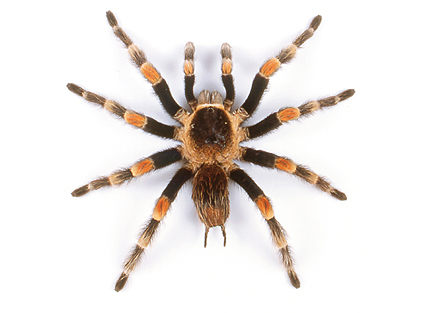Theraphosidae - Tarantulas
Not true spiders, Tarantulas belong to the superfamily Mygalomorphae and are often referred to as "Hairy Mygalomorphs" (true spiders belong to the superfamily Araneomorphae). Theraphosidae (one of several families within the Mygalomorphae) is the familial name of the Tarantulas. The word "Tarantula" is derived from the Old Italian word "tarantola", derived from the name of the town Taranto (located in southern Italy). In the fifteenth century Taranto was (and today still is) home to the European wolf spider (Lycosa tarentula). For some reason, this spider struck fear into the local population and was blamed for "tarantismo". Tarantismo and it's cure, a dance called the "tarantella" are not considered medically valid and are instead attributed to the complex socio-religious oppression of the time. Nonetheless, the idea of the dangerous "tarantola" had been planted. When the exploration of the New World began, large Hairy Mygalomorphs were encountered and the name "tarantola" was used to describe them. Through the years, "tarantola" became "tarantula". The Theraphosidae are also known by many other names, depending on where you are in the world. African species are known as "Baboon Spiders" while certain Asian species are called "Earth Tigers". A nineteenth century European tale from the New World created yet another cognomen for the Theraphosidae. When the Amazon Jungle was investigated, several explorers recounted observations of giant, arboreal spiders eating small birds. Today, many species of Theraphosidae from both the Old and New Worlds are known as "Bird-eating Spiders", or "Bird-eaters" for short. Regardless of the name by which they are known, the Theraphosidae are certainly unique. The most obvious difference separating the Tarantulas from the true spiders is the arrangement of the fangs. Tarantula fangs have only a single point of articulation while true spiders have fangs that are capable of much more movement. A less obvious difference is their lack of a cribellum, the comb-like structure possessed by more highly evolved spiders that helps them manipulate their various types of silk. Differences like this show the ancient lineage of the Theraphosidae. We do not sell live Tarantulas as there is already an extensive group of dedicated breeders that provide that service.
 Blood-Leg Tarantula A.K.A. Mexican Beauty (Brachypelma boehmi)
Blood-Leg Tarantula A.K.A. Mexican Beauty (Brachypelma boehmi)
 Skeleton Tarantula (Ephebous murinus)
Skeleton Tarantula (Ephebous murinus)
 Chilean Rose-hair Tarantula (Grammostola cala)
Chilean Rose-hair Tarantula (Grammostola cala)
 Steely Blue-Leg Bird-Eating Spider (Pamphobeteus antinous)
Steely Blue-Leg Bird-Eating Spider (Pamphobeteus antinous)


